Jen Nowlin Has the Answer.
Jen Nowlin is a Principal Consultant at Vervint. With more than 20 years of experience connecting people, products, and places, she is an expert in both the business and technology of the Internet of Things (IoT). Working across the complete IoT value chain over a wide range of use cases with Verizon and other leading companies, she has successfully brought IoT solutions to market and created market engagement programs effectively leveraging integrated, strategic partnerships with large corporations and start-ups.
We asked Jen to take us through the process of building a successful connected product, from the consideration phase to ensuring customer and product lifetime value.
Q: What does a typical day look like for you?
I help clients with centralization, customization and realizing business value during this strategic challenge. It requires deep analysis and thinking to develop custom frameworks for IoT business value as well as consumer value.
My day is spent testing and iterating with clients to see how they respond to the strategy framework and how they can adopt it as their own. I’m always capturing notes on the stakeholder’s perceptions because we at Vervint have to be able to map these responses and adapt to meet our clients where they are at in their IoT journey. More than 74 percent of global respondents view strategy and planning as the most relevant contributor to IoT project success. My role as a principal consultant in crafting strategy is crucial to project success.
Q: Why should an organization build a connected product?
IoT enables a conversation with the consumer. It opens the door to interactions and engagement in ways that did not exist before. A lot of IoT initiatives tend to be reactive responses to a competitor’s move. When that’s the primary focus, businesses tend not to make the necessary long-term investment in nurturing and developing consumer-focused conversations and relationships. My question to an organization is this: “Are you willing to play to win, or are you looking to just not lose?”
When companies play to win, they invest in the user experience, in the strategy and planning and in the intentional development of long-term business value. For some organizations who are uncomfortable having a direct relationship with a consumer, I advise them to not use IoT to get into a direct conversation with the consumer, but instead look at partnering with other companies in their ecosystem. Find your place in the digital value chain and how you want to play to “win.”
Q: What major challenges do customers face when they are attempting to build a connected product?
Most companies I’ve encountered have built a connected product — or attempted to do so. In these cases, the conversation has shifted from “are you building a connected product?” to “what are you doing for the business side of connected products?” Companies have to evolve and get into the business of managing a system of things featuring multiple connected products. What is the best model to do that at scale? It’s one thing to build a connected product and launch it; it’s another to be in the business of connected products and managing those systems to scale and deliver true value. Companies tend to struggle with this business vision when they are close to launch or after a launch.
Q: What are the challenges when it comes to an organization being proactive during connected product development?
To be proactive during a connected product development is to be able to look at that development in phases centered on curating the human connection with the technology you are providing. One of the ways to do that is through phased delivery of value. Because IoT predominately begins with a product and a person that has never had this capability available to them before, there are typically not many pre-existing expectations on the part of the consumer. One way to be proactive is to understand from the user experience what is the minimal, most important element of value that, when introduced, will compel someone to engage. You also need to ensure that you can consistently deliver on the promise of value you promote. When you can do that consistently and keep users engaged over the product lifecycle, you will have created customer lifetime value as well as product lifecycle value.
Q: Have you seen companies go through this transition successfully?
We are at a key inflection point for this time of year. It’s strategy season. People are looking to 2021 and saying, ‘What do I prioritize? Where do I invest?’ What is driving those conversations? The struggle of evolving from having built connected systems to the business of managing all these connected systems at scale.
These conversations are difficult because where you started is not what will get you where you need to go.
Then businesses begin having conversations about centralization, which is at odds with the need for customization for products and customers within a connected initiative. Often, business units don’t want to give up control to a new group that is going to take on management and responsibility of common attributes for IoT platforms. Core aspects like security and cloud data infrastructure management need to be centralized to gain scalability and cost optimization. Conflict especially arises when there’s a mismatch between the speed of business knowledge and the speed of knowledge shared across the organization.
Vervint: Your Strategic Partner for Smart Product Design and Development
At Vervint, we believe in open innovation collaboration and curating human connection with technology. We’ve got your back in everything we do. Want to talk to an expert? Contact Vervint today.


